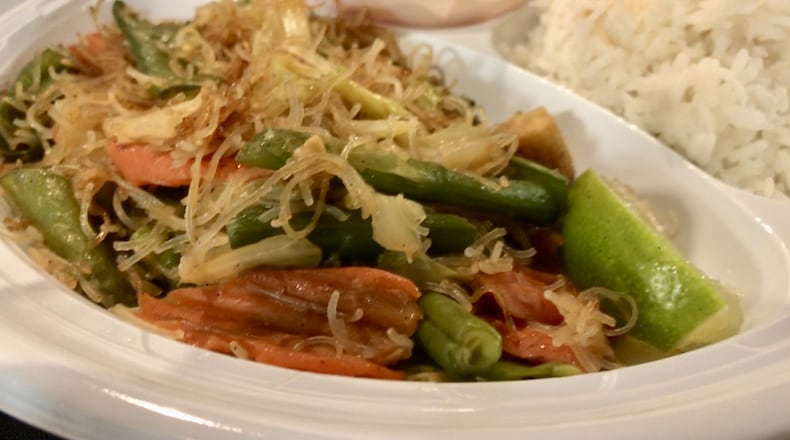Despite my Filipino name, only a quarter of the blood that flows through my veins is Pinoy. It’s when I’m with my dad’s family, though, that I sometimes feel full-blooded.
When I walk into my relatives’ homes in Chicago, there is a distinct smell, and it emanates from the kitchen. I think it’s primarily the rice pot, which claims counter space, much like a coffeepot does in a typical American home. There is also the aroma of pork, and the scent of vinegar, an essential component to the Filipino gift to the world: a marinated, then braised meat dish called adobo. One other smell: frying oil, especially for Filipino-style egg rolls called lumpia. Put it all together and that’s the Filipino smell for me. Plus soy sauce; a bottle is always within arm’s reach.
If you’re not acquainted with Filipino food, the primer would be that Filipino cuisine is a melting pot, a mix of native ingredients but spiced, sauced, and sometimes doused with influences from Spain, Mexico, China and the U.S., among others. Oh, and Filipinos really love pork.
There are few Filipino restaurants in the U.S., and options are scant in metro Atlanta, too. There's Kuya's Food Express at Assi Plaza in Duluth. I've attended a Filipino pop-up called Upper Room by chef Andrew Bantug, trekked north to Rico's World Kitchen in Buford to try the lumpia on that globally inspired menu, and scouted the couple of aisles at Manila Mart, a tiny market on Buford Highway that offers some Filipino canned items but makes a refreshing halo-halo, a classic Filipino frozen dessert of shaved ice doused in evEM-dummyText [...]? aporated milk and layered with coconut flakes, jackfruit, white beans and mung beans, crispy rice cereal and purple yam ice cream called ube.
Adding to the options since last summer is Janet's Kitchen. Located in the restaurant strip on Clairmont Road next to Community Q in Decatur, Janet's offers a mix of Filipino and soul food. It's a venture by Decatur native Nycole Sanders and inspired by her deceased mother, Janet Armstead, the restaurant's namesake, who operated a catering company in Atlanta for four decades. When I spoke with Sanders last July, she said that the restaurant would feature Filipino recipes by her husband and Manila native, Lester Francisco, as well as some of her mom's Southern recipes.
When you enter Janet’s, it is immediately evident that this place is about food, not frills. It’s a counter-order spot that seems to do steady takeout business, but even if you take a seat in its small dining room, you’ll eat on disposable dishware. The Philippine flag on the wall, mini flags set atop its handful of tables, is about as adorned as it gets.
The menu is brief. There is exactly one appetizer — lumpia. But the deep-fried snack is offered with two filling options: shrimp and veggies or pork and veggies. You can tell the difference between these egg rolls and Chinese ones by the size. Lumpia tends to be thinner, like a cigarillo as opposed to a cigar (think: taquito, but flakier). The ones at Janet’s were as tightly wrapped as I could hope for, but the filling not so flavorful; the pork, in particular, was barely pronounced in seasoning.
The limited lineup of entrees includes two of the most widely known Filipino dishes: adobo and pancit. A serving of chicken adobo brought a leg and a breast while pork adobo was a generous portion of pork chunks. Prior to cooking the meat, adobo is marinated in a mix of vinegar, soy sauce, garlic, bay leaves and black peppercorns. The version at Janet’s held the abrasive tang my taste buds anticipated, but my Filipino dining partners found the vinegar overpowering. To be fair, they noted, it could be a matter of upbringing: In Francisco’s (and my grandfather’s, as well) native Manila, adobo is generally more vinegar-y in profile than in the Philippine province of Cebu where my friends grew up. However, neither the pork nor the chicken adobo held the depth of flavor that soy sauce, garlic, bay leaves and black peppercorns usually lend to the dish.
Pancit refers to noodles in Filipino cuisine, and there are oodles of noodle versions out there. The one on the menu at Janet’s is a vegetarian rendition of pancit bihon (stir-fried rice noodles with vegetables and meat, often Chinese sausage, the flavor amped up with onion, soy sauce and fish sauce). Here, one finds cabbage, baby corn and snow peas tangled among the rice noodle threads, but this dish tasted so generic as to be better described as an “Asian noodle dish” than pancit.
Whereas pancit lacked personality, chicken sisig sung with flavor. Spooning back and forth between chicken pieces seasoned with chiles, lime and onions and the accompanying white rice was highly satisfactory. What was odd, however, is that Janet’s sisig seems to be a distant cousin to its ancestor. Sisig means “sizzling,” and the dish (more frequently, it is made with pork parts rather than chicken) is usually served on a sizzling plate. Here, we must settle for a plastic partitioned plate.
Likewise, dine-in patrons will have to tolerate soup served in plastic pint containers. Then again, I won’t repeat an order for chicken tinola soup — hunks of chicken with bok choy bobbing up and down in a nondescript chicken broth.
One of the most interesting dishes is one that isn’t on the menu: cornbread. A complimentary dinner offering, it’s a Southern-Filipino fusion, a hybrid of cornbread and bibingka, a dessert made with rice and coconut milk. Moist, slightly sweet and the top nearly caramelized, it tasted more like corn cake than cornbread, but a creative way to combine two cuisines while also turning a meal ender into a starter.
Though I wouldn’t label it “Filipino,” a mango salad was bright with ripe fruit and snappy with red onion. The majority of sides, though, are Southern. Collard greens were liberally sweetened with brown sugar; black-eyed peas tasted bland and pasty; mac and cheese was tinny.
Janet’s offers canned juices like calamansi and mango, but does not offer alcohol nor has plans to do so — despite two bars in the dining room with cocktail glasses hanging overhead. One bar appears to be used more like an office. The other is cluttered with random cooking gear and boxes.
It’s hard to take seriously a restaurant that doesn’t seem interested in spiffing up the appearance of its dining space and serves eat-in guests soup in plastic pint containers. But considering Janet’s affordability (entrees cost between $10 and $13, depending on whether you want one or two sides — and the daily lunch special of an entree, lumpia, one side dish, white rice and a fountain drink is $9), it is a viable alternative to that most classic of ethnic takeout joints: Chinese. While the menu is hardly expansive — although a follow-up call revealed that Filipino barbecue is slated to begin in late January and soul food entrees of fried catfish and smothered pork chops will debut in February — and dishes don’t always hit the mark, Janet’s Kitchen does bring a Filipino taste worth trying to Decatur.
JANET’S KITCHEN
Noon-9 p.m. Tuesdays-Saturdays, noon-8 p.m. Sundays. 1359 Clairmont Road, Decatur. 404-549-7808, janetskitchenatl.com.
Recommended dishes: pork adobo, chicken sisig.
About the Author
Keep Reading
The Latest
Featured






